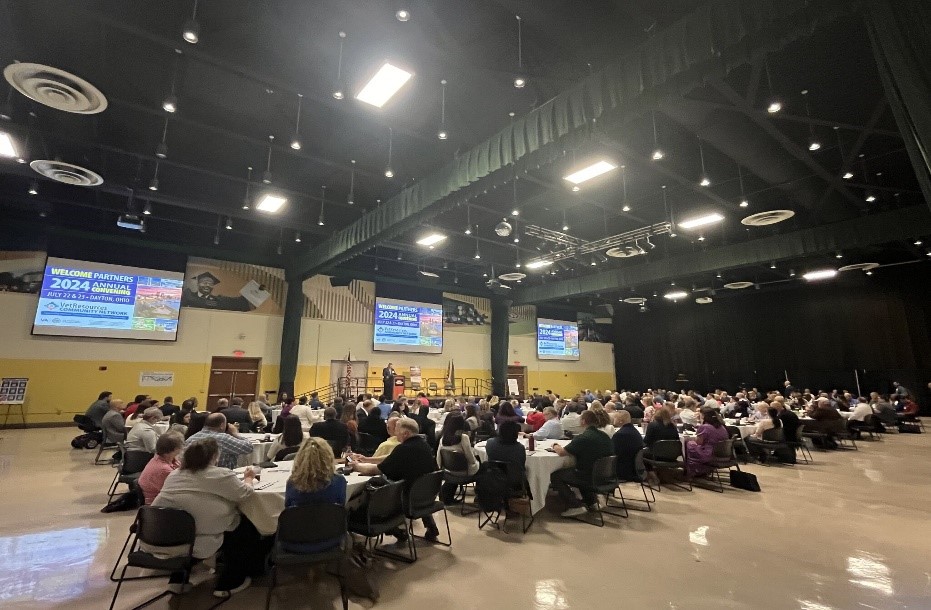Nearly 300 Veteran collaborators, leaders and community members representing hundreds of Veteran organizations met in Dayton, Ohio, to improve the experience for transitioning service members. VetResources Community Network (VRCN) holds quarterly and national convenings aimed at improving outcomes for Veterans and their families.
VRCN is VA’s front door for community and non-profit collaboration, working regularly with more than 600 outreach partners on issues from Veteran Transition, gaming, employment, outreach and more.
Transitioning from military to civilian life can be a cause for celebration, but for many Veterans it can be the great unknown. Life changes fast, from translating military-specific skills to a career, adjusting to civilian culture, to even the basics of where to live and receive health care. All while hopefully staying connected to their military and now Veteran support network.
This year’s VRCN National Convening was held at Wright State University in Dayton, Ohio, and hosted in collaboration with VA’s first ever Community Catalyst Award. The Greater Miami Valley myVeteran Community, Dayton’s Community Veteran Engagement Board (CVEB), was chosen for this award as an active, scalable, community engagement example of excellence.
“From the very beginning of our CVEB days in the Dayton Region in 2015, we built collective impact into everything we do. Our CVEB team is part of a well-oiled machine delivering the best services that we can to our Veterans and spouses across the region. Our many Veteran Serving Organizations don’t compete with each other; we complement and amplify each other’s work for the betterment of our community and all of our regional Veterans,” said Miami Valley MyVeteran Community Founder and chair Cassie Barlow.
Dayton is also home to the future National VA History Museum located on the historic Dayton VA campus. Convening participants had a chance to tour the campus and learn more about VA’s history from VA’s Chief Historian Michael Visconage.
The convening was a snapshot of what VRCN does best—gathering the Veteran serving community under one roof to intensify its impact and outcomes for Veterans, families, caregivers and survivors. Attendees heard from VA senior leaders VA Deputy Secretary Tanya Bradsher and VA Chief Veterans Experience Officer John Boerstler, along with senior leaders from Department of Defense Ashish S. Vazirani, acting Under Secretary of Defense for Personnel and Readiness; and Department of Labor James D. Rodriguez, assistant secretary for Labor’s Veterans’ Employment and Training Service (VETS), which focuses on personnel readiness and employment services. The convening also included hands-on table-top solutioning exercises and cross-agency chats.
Constantly evolving from past event attendee feedback, the convenings shift to have more of an impact on specific Veteran challenges. One participant remarked, “I attended the Veterans Affairs 2024 Annual National VetResources Community Network Convening last week. I wanted to let you know I really enjoyed all the sessions. It was one of the most open and collaborative conferences I’ve attended, and that was so refreshing.”
VA’s Veterans Experience Office leads VRCN and any Veteran-focused organization may request to join. Learn more about the VRCN, partnerships, outreach efforts, upcoming community engagement events and how to join.
Topics in this story
More Stories
MyVetBENEFITS is a free, easy-to-use third-party mobile app and website that matches Veterans to the benefits they’re most likely eligible for.
Together We Served has launched a new free service called "Veteran Buddy Link" to assist Veterans seeking friendship and support.
Since 2010, more than 36,000 individuals have benefited from ACP's mentorship program, which equips Veterans and military spouses with the tools and resources to pursue meaningful employment.






I had joined the Air Force in 1986 and was out little over 3yrs later due to an injury. They med boarded me out with 10%SC. I had met with a VSO and got that upgraded to 20% fairly soon. I had some pain in my gut and after a few years, a resident at a cboc notice I had the signs of gall bladder issues. VA was so different in 1992. I had surgery at White River Junction VA, everything was still on paper, very few females went to VA and I was the only female inpatient. They had to move the male patients around to make room to put me so I had a room to myself but still had to share the bathroom with a male. They took good care of me though and I was grateful to them. Generally speaking most care I have received has been good. I have had to fight for my increases in service connection. I got out in 1989 and still fighting the good fight.
I left the USAF in 1992 as part of an early out program. My husband and I were both Active Duty and he was cheating, so we got divorced and I got out to take care of our daughter who was 7.
The help I received to transition into the civilian life after almost 13 years, was “don’t let the door hit you on the way out “. I didn’t get any help. I finally got into the VA system in the early 2000s, but the care was terrible. I nearly died from a misdiagnosis of my gallbladder (had emergency surgery in a civilian hospital), and the shots in my shoulder were given without numbing meds and guesswork about where to put the cortisone in.
This year, I finally had the courage to ask for a reevaluation of my disability and to my shock, it was upgraded.
The injury happened in the 1980s on duty, and 40 years later, I am receiving compensation.
I’m glad that new Veterans are receiving better treatment these days.
Thank you for dong this.